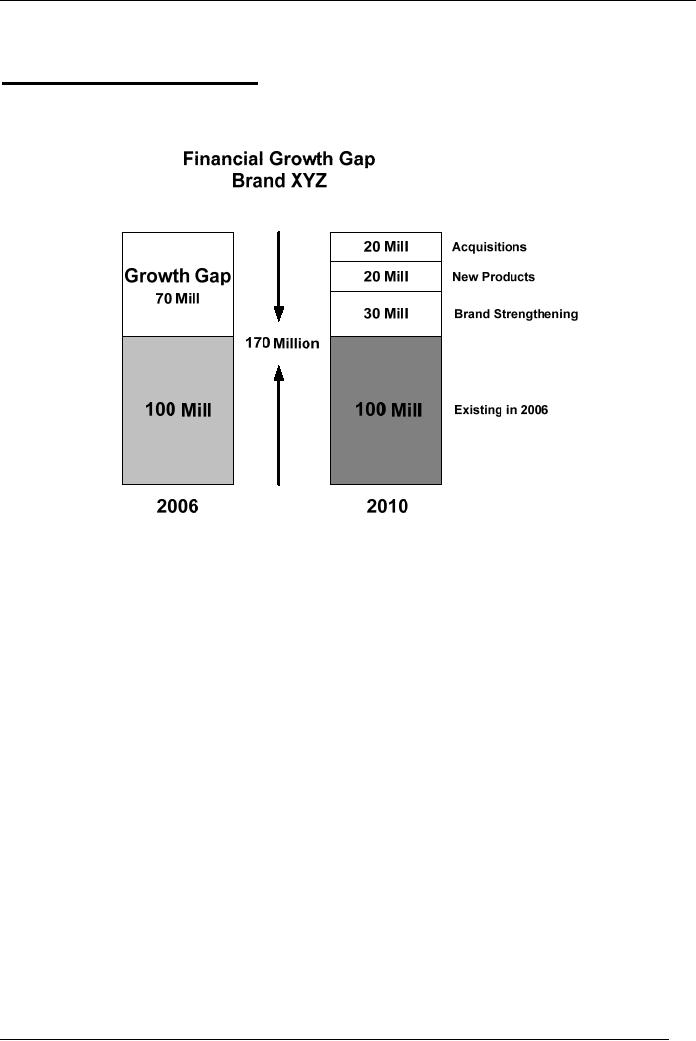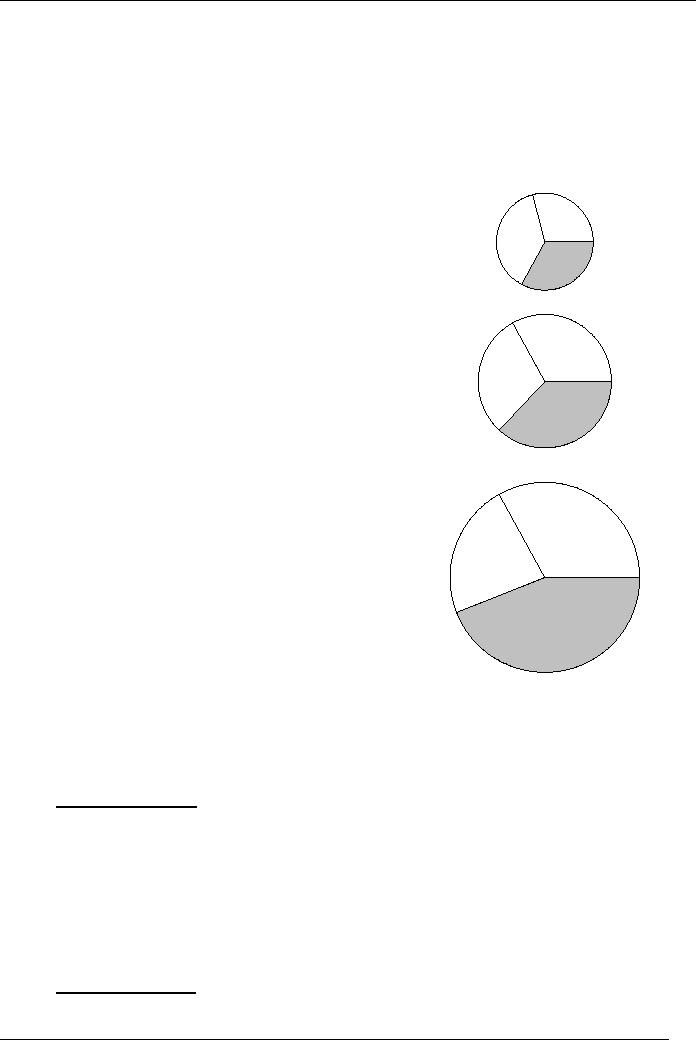 |

Brand
Management (MKT624)
VU
Lesson
9
BUILDING
BRAND VISION
Answers
to filling the growth
gap
The
answers could be best obtained
with the help of the
following figure 13.
Figure
13
Source:
Scot M. Davis: "Brand Asset Management
Driving Profitable Growth through
Your Brands"; Jossey-
Bass,
A Wiley Imprint (46)
The
company plans to register
sales revenue of RS.170
million by the end of 2010.
The
existing
revenue level of year 2006 is
RS.100 million. The plan, in
other words, envisages
a
growth
of 70 percent, which translates
into a yearly average growth
rate of 17.5 percent.
(This
is
a hypothetical situation and does
not represent a real life
company case; in real life a
growth
rate
of 17.5 percent is very high
and is witnessed only in high
growth industries).
The
challenging part is how to
achieve what is envisaged. The
senior management is convinced
that
additional revenue of RS.70
million will come from a combination of
the following
strategic
moves:
�
Strengthening
of existing brand(s)
�
Introduction
of new products, and
�
Acquisitions
The
questions of brand managers
regarding how to fill the
contribution gap stand answered.
What
the above reveals is that no
single move can bring the
company the desired level
of
growth;
rather, it needs to move
into three strategic
directions to achieve the
objective.
The
brand and marketing management
know what they need to
plan to strengthen the
existing
brand(s),
to introduce new brands, and to formulate
moves for brands that are
planned to be
acquired.
The
intended targets of acquisitions may
not be revealed to brand management
immediately at
the
time the top management
envisions to do so. But, the
fact remains that acquired
brands will
also
bring their part of
contribution. Generally, acquisitions
bring with them staff
members at
the
level of brand managers, who get
immersed into company's management and
continue
performing
their functions to maintain
consistency.
38

Brand
Management (MKT624)
VU
With
the questions answered, brand
managers find themselves a
step further in building
the
brand
vision toward a clear
picture of the brand.
3.
Collect industry data and create a
brand vision
starter
Translation
of visionary thinking into
financial and strategic goals must
have a base. Nothing
could
provide a better base than
analyzing the industry the
company is a part of.
Industry
analysis
comprises the following:
�
Defining
the industry
�
Determining
industry growth and size
�
Key
growth factors
�
Seasonality
�
Industry
lifecycle
Defining
the industry: Defining the
industry is the first step
toward the analysis. You
must
consider
the following:
A
description of the economic sector
that the industry occupies
manufacturing,
services,
distribution, or any
other
The
range of products and services offered by
the industry
A
description of the geographic
scope of the industry
whether local,
regional,
national,
or international
The
industry definition may also
include a listing of major
market segments. For example,
a
computer
manufacturer may divide its
market into desk top
computers, laptops and
notebooks,
and servers for web
hosting.
The
idea is to find a definition
that is broad enough to include
all of the company's
major
competitors
but narrow enough to permit
useful comparisons. However, it is
better to be a
little
broad than being too
narrow.
Market
Share
Industry
size and growth: You have
Figure
14
Years
2006 - 2008
to
determine the current size of
the
industry
for the company's
products
2006
or
services. You can determine this
through
published data or
informal
ABC
MNP
XYZ
means
and arrive at numbers for
total
units
sold and revenue generated
by
29%
38%
33%
all
the players in the
industry.
You
can then go on to determining
the
annual growth rate
of
yesteryears,
project for the next
few
2007
years
and compare that with
your
company's.
That will show you
how
you
seem to be growing as much
as
33%
31%
37%
the
industry, faster, or slower.
Such
analysis
will also enable you to
compare
your company's growth
with
other major
competitors.
2008
Figure
14 exhibits market
shares
enjoyed
by three different companies
33%
23%
44%
ABC,
MNP, and XYZ as projections
for
a three-year period.
39

Brand
Management (MKT624)
VU
Company
XYZ shows a consistent rise in its
market share at the expense
of the other
two
companies. Company MNP is losing
over the three-year period,
while company
ABC
is barely maintaining the
marginal growth it is projecting to
register in year
2007.
This
kind of a comparison helps
managers develop a realistic
picture of the
industry
and,
hence, the standing of their
own company while they
are in the process of
developing
a vision for their
brand.
Another
factor that brand managers
should
Industry
Growth
Figure
15
consider
while analyzing market is
the
Years
2006-2008
growth
of the category or market.
The rise or
2006
drop
of market shares as projected
for the
ABC
three
companies can be interpreted in
yet
29%
another
way giving the managers
better
38%
MNP
insights
into the movements of
different
33%
XYZ
players.
It
is evident from figure 15
that company
2007
XYZ
has a market position
stronger than it
may
look from the preceding
figure 14. This
33%
company
is gaining market share in a
fast
30%
growing
category, which is different
from
having
the same level of shares in
a category
37%
that
is growing slower or is
static.
Company
MNP is dropping its share
fast over
the
three-year period, but may
not be losing
2008
the
volume as fast. The volume
may still be
the
same as it is in the year
2006. Although a
consolation
by way of utilizing
the
33%
production
capacity, the company
definitely
23%
is
not growing and is on the
declining path.
Company
ABC may be static in terms
of the
market
share, but it is gaining volume
on
yearly
basis. The situation,
however, is not as
44%
rosy
as that of XYZ and company ABC is
not
reaping
optimal benefits of the
category
growth.
Refer to the advantages that
number
one
brand enjoys as per the PIMS
findings in lecture 2.
Such
analyses arm the brand
managers with analytical
insights into
realistic
comparisons
and solid basis for
developing the right vision
for their brands.
Key
growth factors: Growth
factors are trends and
conditions beyond the
control of the
industry
or firms within it. Such
factors significantly affect
market growth and the
level
of
demand, hence having impact on
all.
The
car and electronic industries in Pakistan
have undergone a tremendous
growth
phase
owing basically to bank
financing, which is easily
available. The access to
bank
financing
is the key growth factor,
which has given a new
shape to the whole
supply
chain
of the two industries. The
level of demand on part of those who
are into
manufacturing
of car accessories and electronic parts
for TVs, for example,
has
witnessed
a growth rate unprecedented in the
past.
Cyclical
Influences
Cyclical
industries are those that
are directly affected by the
rise and fall of external
economic
cycles, usually the national
business cycle. Cyclical
industries generally do
40

Brand
Management (MKT624)
VU
well
during strong periods of growth and do
poorly during recessions.
Typical cyclical
industries
are manufacturing (consumer
durables) and construction (cement and
other
building
materials), to name a couple.
Cyclical
patterns should be identified to
know the strengths and
weakness of such
industries,
if those affect your business.
Seasonality:
It refers to the distribution of
business activity during the
year. If an
industry
is subject to seasonality, then
its sales in one part of the
year are
disproportionate
to the other part of the
year. For example ice cream and
cold drinks
have
a higher level of demand in the
typical season of summer.
Brand managers must
consider
such seasonal variations
while they are in the
process of developing the
brand
vision.
Industry
life cycle: It is important to
know the level of maturity
of an industry. There
are
four stages that
characterize maturity:
o
Embryonic
o
Growth
o
Mature
o
Aging
You,
as brand managers, have to see
what stage the industry is
in and how you relate
to
that
cycle (one of the above four
stages) in terms of growth
rate, market share,
product
line
planning, investment in technology
etc.
4.
Meeting with top management to create the
vision
Equipped
with all the relevant
details and information, you
are now in a position to make
a
presentation
to the top management. In
all chances, the findings
should be acceptable to
all
since
many vital factors in the
report owe their inclusion
to information from the
top
management.
It can still be debatable, but you
have a chance to defend the
bases that have
led
to
the conclusion. It offers a good
opportunity to iron out any
differences that brand
and
marketing
management may have with
other departments for the good of
the brand.
A
consensus on the report puts
the company on the course to
developing a clear brand
picture,
which
is the next strategic step
in the brand management
process.
BRAND
PICTURE
The
second step of the strategic
brand management process is development
of brand picture.
Toward
creating the right picture,
you have to do everything possible to
create the right
image.
The
whole exercise of creating the
right picture is to create
meaningful parallels between
the
brand's
identity and its image. We know by
now that more the image
coincides with
identity
the
more brand managers are
successful in communicating the
right identity and creating
the
right
image.
Creating
the right identity is of
paramount importance, for it
means that the product
has been
given
the right meaning that will
be rightly received at the
consumer's end. Creating a
brand,
therefore,
is the end of the process
that is the sum total of
all company resources
deployed to
create
the point of difference that
highlights brand's
identity.
Brands
therefore are born out of
the marketing strategies of
differentiation and segmentation,
as
is
already clear from the
discussion on all preceding concepts in
general and the example
of
company
XYZ's vision statement in
particular.
41

Brand
Management (MKT624)
VU
The
soul of branding
Branding
is not just putting a name on
top of a product. Branding is
that you do inside of
the
product,
that is, give it meaning
through creating the point
of difference in a way that
its
identity
is taken at the receiving end
the way it is intended. It is
because of such an identity
of
powerful
brands that you look at them
as relevant and genuine even in
the absence of a label2.
You
do not give the same
treatment to a fake brand
even if it carries the label
that may look
genuine.
Why? Because the actual
brand (the inner soul) is
not there! The brand name
is
visible,
yet the brand is absent. The
image, in other words, that
consumers have of the
two
products
is different. In case of the
original, it has the top of
the mind image; in case of
the fake
one,
it has the bottom of the
mind image.
How
to develop the right
picture?
The
question is how do you
create a brand that injects
into the product what
gives it the right
image?
The first task toward doing
that is to envision3:
�
What
attributes materialize?
�
What
advantages are
created?
�
What
benefits emerge?
�
What
obsessions does the brand
represent?
A
brand picture has to answer
all the
Brand
Picture Process
Starter
questions.
A simple question that
embodies
all
the above-mentioned four
questions is,
"what
would the market lack if
our brand
Right
Segment
was
not there?" If the answer is
nothing, then
the
brand managers may not go
ahead with
the
brand development.
If
the answer is substantive,
then the
substance
will be found systematically
through
the above four questions in
knowing
Right
the
features, advantages, benefits, and
the
Differentiation
Figure
16
obsessions
the brand offers. Therefore,
once
brand
managers are gone ahead with
the right
vision
and the purpose, the right image
will
result.
Figure
16 illustrates the
process of
Right
Product
developing
the brand picture - right
segment,
right
differentiation, right product,
right
identity,
the right image!
The
right picture gives you
the right basis
for
the
brand strategies that will
leverage the
brand
the way it is envisioned. An
important
thing
to keep in mind is that
brand picture is
Right
Identity
externally
driven with customers as the
focal
point3. It
takes into account customer
needs
and
the competition. The
competitive
environment
gives you the right
customer
perspective
regarding your product
vis-�-vis
competition.
Right
Image
42

Brand
Management (MKT624)
VU
Summary
- lectures 8 and 9
Building
brand vision is the first
step of the strategic brand
management process. To
leverage
your
brand, you should build up
the brand vision by
considering all possible strategic
factors
like
growth the company envisages,
the ability to reach strategic
goals, introduction of
products
and
then sustaining those
products.
Brand
managers must start the
process by seeking top management's
input on matters of
strategic
moves before they develop
the right vision, which
leads to developing the
right brand
picture.
The whole process is very
strategic and therefore must take
into account why a
particular
segment should be served and how the
company offering will best serve
that segment
of
the market.
Identification
of the right segment will enable the
brand managers to develop
the right product.
Identity
of the product, if created
right, will lead to the right image
that lays the foundation
for
the
right brand picture.
Bibliography:
1.
Jean-Noel Kapferer: "Strategic Brand
Management"; Kogan Page
(47)
2.
Jean-Noel Kapferer: "Strategic Brand
Management"; Kogan Page
(47)
3.
Scot M. Davis: "Brand Asset
Management Driving Profitable
Growth through
Your
Brands";
Jossey-Bass, A Wiley Imprint
(53)
Suggested
readings:
1.
Scot M. Davis: "Brand Asset
Management Driving Profitable
Growth through
Your
Brands";
Jossey-Bass, A Wiley Imprint
(37-48)
2.
Jean-Noel Kapferer: "Strategic Brand
Management"; Kogan Page
(46-59)
43
Table of Contents:
- UNDERSTANDING BRANDS – INTRODUCTION:Functions of Brand Management, Sales forecast, Brand plan
- INTRODUCTION:Brand Value and Power, Generate Profits and Build Brand Equity
- BRAND MANIFESTATIONS/ FUNDAMENTALS:Brand identity, Communication, Differentiation
- BRAND MANIFESTATIONS/ FUNDAMENTALS:Layers/levels of brands, Commitment of top management
- BRAND CHALLENGES:Consumer Revolt, Media Cost and Fragmentation, Vision
- STRATEGIC BRAND MANAGEMENT:Setting Objectives, Crafting a Strategy, The Brand Mission
- BRAND VISION:Consensus among management, Vision Statement of a Fast Food Company, Glossary of terms
- BUILDING BRAND VISION:Seek senior management’s input, Determine the financial contribution gap
- BUILDING BRAND VISION:Collect industry data and create a brand vision starter, BRAND PICTURE,
- BRAND PICTURE:Brand Value Pyramid, Importance of being at pinnacle, From pinnacle to bottom
- BRAND PERSONA:Need-based segmentation research, Personality traits through research
- BRAND CONTRACT:The need to stay contemporary, Summary
- BRAND CONTRACT:How to create a brand contract?, Brand contract principles, Understand customers’ perspective
- BRAND CONTRACT:Translate into standards, Fulfill Good Promises, Uncover Bad Promises
- BRAND BASED CUSTOMER MODEL:Identify your competitors, Compare your brand with competition
- BRAND BASED CUSTOMER MODEL:POSITIONING, Product era, Image Era, An important factor
- POSITIONING:Strong Positioning, Understanding of components through an example
- POSITIONING:Clarity about target market, Clarity about point of difference
- POSITIONING – GUIDING PRINCIPLES:Uniqueness, Credibility, Fit
- POSITIONING – GUIDING PRINCIPLES:Communicating the actual positioning, Evaluation criteria, Coining the message
- BRAND EXTENSION:Leveraging, Leveraging, Line Extension in detail, Positive side of line extension
- LINE EXTENSION:Reaction to negative side of extensions, Immediate actions for better managing line extensions
- BRAND EXTENSION/ DIVERSIFICATION:Why extend/diversify the brand,
- POSITIONING – THE BASE OF EXTENSION:Extending your target market, Consistency with brand vision
- DEVELOPING THE MODEL OF BRAND EXTENSION:Limitations, Multi-brand portfolio, The question of portfolio size
- BRAND PORTFOLIO:Segment variance, Constraints, Developing the model – multi-brand portfolio
- BRAND ARCHITECTURE:Branding strategies, Drawbacks of the product brand strategy, The umbrella brand strategy
- BRAND ARCHITECTURE:Source brand strategy, Endorsing brand strategy, What strategy to choose?
- CHANNELS OF DISTRIBUTION:Components of channel performance, Value thru product benefits
- CREATING VALUE:Value thru cost-efficiency, Members’ relationship with brand, Power defined
- CO BRANDING:Bundling, Forms of communications, Advertising and Promotions
- CUSTOMER RESPONSE HIERARCHY:Brand-based strategy, Methods of appropriations
- ADVERTISING:Developing advertising, Major responsibilities
- ADVERTISING:Message Frequency and Customer Awareness, Message Reinforcement
- SALES PROMOTIONS:Involvement of sales staff, Effects of promotions, Duration should be short
- OTHER COMMUNICATION TOOLS:Public relations, Event marketing, Foundations of one-to-one relationship
- PRICING:Strong umbrella lets you charge premium, Factors that drive loyalty
- PRICING:Market-based pricing, Cost-based pricing
- RETURN ON BRAND INVESTMENT – ROBI:Brand dynamics, On the relevance dimension
- BRAND DYNAMICS:On the dimension of knowledge, The importance of measures
- BRAND – BASED ORGANIZATION:Benefits, Not just marketing but whole culture, Tools to effective communication
- SERVICE BRANDS:The difference, Hard side of service selling, Solutions
- BRAND PLANNING:Corporate strategy and brands, Brand chartering, Brand planning process
- BRAND PLANNING PROCESS:Driver for change (continued), Brand analysis
- BRAND PLAN:Objectives, Need, Source of volume, Media strategy, Management strategy